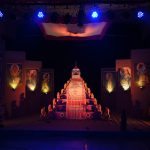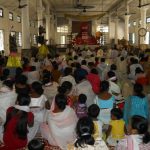Srimanta Sankaradeva founded a new order named Eka Sarana Nâma Dharma. This nomenclature itself defines his ideology. Eka Sarana means refuge in one entity alone. That is none but lord Krishna, who is identified with the supreme absolute Brahman in this order.1 This idea of taking refuge in only one entity precludes worship of any other entity. There lies the distinctiveness of Eka Sarana Nâma Dharma from other Vaishnavite orders. Whereas all other Vaishnavite orders advise worship of the Lord with His consort, Eka Sarana Nâma Dharma insists on worship of the Lord alone. Even the Alwars sang eulogies of several female deities in their hymns compiled in Nâlâyir Dibya Prabandhakam. Moreover other Vaishnavite orders permit worship of more entities in addition to the Lord’s consort. For example the worshippers of Vishnu would worship Shiva also, because of which the Vaishnavite temples would have Shiva idols too. 2 But that was not to be in Eka Sarana Nâma Dharma. One (Eka) means only one in this order. There was a social cause behind this stringency apart from the philosophical logic. The decadence of Tântricism and the Vajrayâna Buddhism had devastated the society in the medieval times. The Sahajiyâ cult had spread unhealthy customs in the society in the name of religious exercises. There were dirty practices in the name of female deity worship. Honour of women was at stake due to these distorted practices. This too might have been a reason why female deity worship was totally dispensed with by Srimanta Sankaradeva in his order.
The concept of Nâma Dharma defined the philosophy of Srimanta Sankaradeva. He used the name of God both as tool and goal. Chanting the name and attributes of God was the prescribed method of worship in his order. At the same time he declared that God was personified in His name. This equality of goal and tool sounded absurd but it was true. Srimanta Sankaradeva took the name of God as the form of God, whom he worshipped in shapeless form. Thereby he brought about union of two contradictory concepts – Saguna and Nirguna aspects. As the name of God was his instrument as well as the goal, he could declare that his personal God lord Krishna was none but Brahman. Praying to God, Who also happened to be Saguna as He could be visualised in a form, by chanting His name was termed as a Nirguna method of worship. 3 This synthesis thus brought about the union of two parallel paths in Sanâtana religion – Jnâna Mârga (Path of Knoweldge) and Bhakti Mârga (Path of Devotion). This was an achievement of the highest order as it had remained parallel paths even in Srimadbhagavadgeetâ.
These features of Eka Sarana Nâma Dharma are seen in Sikhism too. Sikhs also worship God by chanting His name and attributes as in Eka Sarana Nâma Dharma. They also place Guru Granthsâhib in the altar just as Gunamâlâ or Bhâgavata is placed in the altar known as Guru Asana by the followers of Eka Sarana Nâma Dharma. In both the orders the devotees sit on the same level, the ground. We find similar atmospheres in their worshipping places, known as Kirtanghar in Eka Sarana Nâma Dharma and Gurudwârâ in Sikhism. Both the orders serve Prasâda equally to all and in the same place. It is however not surprising. It did not happen by coincidence. All these happened because the founder of Sikhism, Guru Nanak had taken spiritual guidance from Srimanta Sankaradeva. He was indeed a follower of Srimanta Sankaradeva. Nanak first met Srimanta Sankaradeva during the saint’s twelve year long pilgrimage and then again came to meet the saint at Bardowa during his Udâshi in this region. 4
Srimanta Sankaradeva was a genius who created a new institution named Thân, which later came to be known as Sattra. The first such institution was set up at Bardowa. While the Kirtanghar, the central unit of Thân was set up in 1468, other components of Thân were set up in 1509. So the institution Thân in its integrated form came into being in 1509, when the component like Hâti (residences of devotees) were added.5 This Thân institution is not derived from Buddhist monastery as suggested by some but very own of Srimanta Sankaradeva. It had many original features. The name Thân itself is unique for Assam. Though it was originally derived from the Sanskrit word Sthâna; it had been in vogue here since earlier times. There were Saivite Thân, Shaktiite Thân, tribal animism-based Thân in the valley. Srimanta Sankaradeva used this indigenous name for his institution. That made the task of conveying the purpose of the institution to the mass people easier. People identified with him and his order easily. It was also a very intelligent way of incorporating the Shaivites in his order. However the later-day followers of his order started using a fully Sanskrit word Sattra. By that time the concept of Eka Sarana Nâma Dharma had been known widely all over the valley. Thus the nomenclature Thân gave way to Sattra. Nevertheless both the names are unique; such names are not heard of elsewhere in India for religious institution.
Devotees of Eka Sarana Nâma Dharma differ from the followers of Buddhism and for that matter any religion, in many points. The Eka Sarana devotees do not have any fixed dress code like in Buddhism; only the devotees performing Prasanga inside Kirtanghar are required to wear clean white Dhuti on the lower part and a Chelleng spread diagonally over chest during the time of Prasanga. The Eka Sarana devotees do not live on alms like ascetics in other religious monasteries; they eke out their own living, mainly from agricultural works. Every Sattra allot land to the devotees residing in that Sattra.6 Srimanta Sankaradeva did not consider Madhukari Vritti as an essential spiritual exercise. Moreover the residents of Thân had the liberty to live householders’ lives, whereas all ascetics in other religious monasteries had to be necessarily celibates. Women devotees enjoyed all priviledges enjoyed by the male devotees in Eka Sarana Nâma Dharma. Srimanta Sankaradeva initiated both male and female devotees, which was not a common feature in different religious orders.7 Moreover there was no caste restriction in his order, whereas many Vaishnavite order required the devotees to be Brâhmin, especially for carrying out certain designated functions like reciting scriptures, arranging offerings etc.
The system of performing Kirtana was an innovation of Srimanta Sankaradeva. That was why his worshipping place came to be known as Kirtanghar. It meant house for performing Kirtana. The word Kirtana means community chanting of God’s name and attributes. There is record of Kirtana being performed in as early as 1468 under the guidance of Srimanta Sankaradeva.8 So it cannot be an innovation of Chaitanyadeva (1486-1533), who came to be known for his Sankirtana. We have every reason to believe that Srimanta Sankaradeva popularised his method of performing Kirtana elsewhere in India during his twelve year long pilgrimage from 1481 to 1493.9 Therefore the genesis of Sankirtana lay in Kirtana of Srimanta Sankaradeva. Even though Kirtana was counted as one of the nine modes of devotion since long ago, it was only Srimanta Sankaradeva who gave it an institutionalised form. Chaitanyadeva made it further popular. There are different orders performing Kirtana now. But the Eka Sarana Nâma Dharma type of Kirtana remains unique. The community singing in full classical Râga in the accompaniment of cymbals, drum etc make it stand out among all methods of Kirtana.
Srimanta Sankaradeva was a multi-talented person. He can be termed as an architect as he designed his worshipping place Kirtanghar in a different manner from the worshipping places in other orders. The design of Kirtanghar is different from other worshipping places. It is open on three sides unlike the temple/church/mosque/synagogue. It has columns of pillars inside the hall, which too is not seen in most other worshipping places. It was constructed with locally available materials like bamboo, wood, thatch etc unlike the huge stone-made temple structures. That made it possible for the followers to dispense with royal patronage, which was very much essential in other orders to construct expensive temples. Apart from these economic and political aspects, there was the environmental aspect too. All the materials used in Kirtanghar or for that matter in any activity within the Thân or Sattra happeed to be eco-friendly. Bamboo, wood, thatch etc were all replenishable commodities gathered from nature. So nature was not harmed in the least. This was certainly due to the sensitiveness of Srimanta Sankaradeva to ecological issues. He said in his Kirtanghoshâ that one tree was equal to ten sons.
It may be mentioned that Kirtanghar had no Manikut, which now-a-days have a conical dome shaped roof like other temples of Sanâtana religion, in the time of Srimanta Sankaradeva.10 It was a later addition. The conical dome shaped roof above the Manikut was not his idea. He did not design this shape which was similar to other temples of India. His Kirtanghar was a rectangular hall, completely different from temples. When the annexure was added later during the time of Madhavadeva, it was fitted with a concave roof, giving rise to the name Bhâj-ghar. The best example of it is the Kirtanghar in Barpeta Thân. How and when it gave way to the conical-domed Manikut is not exactly known. We guess it was during the Ahom period when the cultural influence of Northern India became explicit through the royal patronage. Rudra Singha ordered the Thâns and Sattras to instal idols, in whose name land grants were made.11 Though it became an aberration in the order, the devotees could not go against the royal decree. The Manikut was added essentially to keep these idols. Even though the puritan ones dispensed with idols later, the Manikut stayed. The puritan ones shifted the Guru âsana from the main hall to the Manikut. In recent times veranda has been added in many Kirtanghar on three or even all four sides which has also diluted the sacredness of the institution. The open main hall also has been converted to a closed hall by raising walls on three sides. However even after all these changes the Kirtanghar remains quite distinctive among all worshipping places.
All the above-mentioned transformations have happened due to lack of any central control like in other orders. These transformations prove the autonomy of each unit. Eka Sarana Nâma Dharma was developed in such a manner by Srimanta Sankaradeva that there was no imposition by any central authority. The followers were given enormous liberty in socio-cultural issues. This is reflected in the acceptance of the regular changes seen in the structure of Kirtanghar. The erstwhile simplicity of Kirtanghar was first done away with by Damodaradeva and then followed suit by Madhavadeva on the advice of Narayanadas Thakur. Even the Sattras are independent on all such issues. One Sattra cannot dictate another. That is why there are so many differences in the customs followed by different Sattras. The Asom Sattra Mahâsabhâ is a century-old co-ordinating body of the Sattras, but it too cannot ask the Sattras to abide by any instruction. Every Thân or Sattra has own management committee, which is constituted democratically and which is the supreme body to decide about the functioning of the respective Thân or Sattra.
The democratic character was unique in Eka Sarana Nâma Dharma; it was not seen in other orders which prevailed in those days. The democratic character of Eka Sarana Nâma Dharma was a legacy created firmly and decisively by Srimanta Sankaradeva’s successor Madhavadeva, when he bequeathed the task of managing the Barpeta Thân to the devotees at large just before his passing away.12 This democratic element in the order was of course inspired by the style of functioning of the founder Srimanta Sankaradeva himself. He made every devotee sit on the same level inside the Kirtanghar. The practice of serving Prasâda equally to all in the Kirtanghar was a great democratic feature. Srimanta Sankaradeva permitted his followers to criticise him and even change his decisions; this happened in cases of Chandari, Madhavadeva, Narayanadas Thakur etc. The evolution of democratic spirit in an otherwise feudal social set-up was a revolutionary step.
A salient feature of the Eka Sarana Nâma Dharma order was that it used cultural activities as a tool of proselytization and also as part of religious pursuits. In the context of proselytization, it was a trend-setter. The message of the Eka Sarana Nâma Dharma was conveyed through the Ankiyâ plays, Bargeet etc. Even the âhârya of Bhâonâ (enactment of Ankiyâ plays) conveyed a distinct message; these were created from ethnic ingredients.13 Thus these attracted the ethnic groups to the fold. But the more interesting feature is that culture was made part of daily life too of the devotees, it did not perform the role of proselytization alone. The devotees performed their prayer etc in musical verse. Devotees living in the premises of Thân or Sattra had to necessarily learn dance and music. One could not stay away from it. Culture was thus an essential component of this order. It was not optional, but essential. This was an unprecedented thing. The followers of Eka Sarana Nâma Dharma have always been very serious about perpetuation of these traditions, originally initiated by Srimanta Sankaradeva and his successor Madhavadeva. So the Thâns and Sattras have made imparting of education about spiritual and cultural traits an essential part of their system. The celibate devotees of Thân or Sattra are brought to the Thân or Sattra right in their childhood and then educated within the Thân or Sattra itself. This is a distinctive system. Nowadays however the young members attend government educational institutions also. But the traditional system continues to be there as a supplementary institution.
Srimanta Sankaradeva was a great scholar of Sanskrit, which is reflected in the analytical book Bhakti-Ratnâkara, his only book written in Sanskrit. But for composing the devotional literature, the language of the mass people was used by him, not the language of the elite scholars like in other orders. That was how Brajâwali came into prominence; it got itself elevated from the status of a dialect to literary language.14 Srimanta Sankaradeva did not use the Sanskrit language, which was the language for writing the scriptures till then. Religious theories had been confined to the elite class of the society till then, because of which the common people could be dominated by the priest class; Srimanta Sankaradeva did away with this malaise. All branches of Sanâtana religion had their own commentaries of Badarayana’s Brahma-Sutra in Sanskrit, but Srimanta Sankaradeva did not bother to do that as he was not eager to establish himself as founder of a new order. This became possible as all his writings except the above-mentioned book were in either chaste Assamese or colloquial Brajâwali. In this respect he stood out among all his Vaishnavite contemporaries and predecessors. He was immediately emulated by others like Jagannatha Das, Tulsidas etc.
In recent times Thâns and Sattras have faced a challenge. Some members have left for other vocations after taking formal education. But the Thân or Sattra survives in spite of such desertion, because of its inherent capacity to sustain itself. Few among them are rich in immobile property inherited since medieval times; they are now playing an important role in the society by using that wealth. Others are taking leadership in cultural arena. Their role has also become significant in the search of the Assamese people for identity. In the process Srimanta Sankaradeva has become a symbol of these people. This is unique.
References :
- Kirtan-ghosha, Srimanta Sankaradeva, verse 519
- Unique contributions of Srimanta Sankaradeva in religion and culture, Dr Sanjib Kumar Borkakoti, Srimanta Sankaradeva Sangha, 1st edition, Nagaon, 2006, pp. 73-78; Purnanga katha gurucharit, Dr Sanjib Kumar Borkakoti, Bani Mandir, 1st edition, Guwahati, 2007, p. 70, 426
- Sankari sahitya aru sanskritir baisistya, Dr Sanjib Kumar Borkakoti, 1st edition, Sankaradeva adhyayanar pracya pratisthan, Guwahati, 2006, p. 6; Srimanta Sankaradeva : an epoch maker, Dr Sanjib Kumar Borkakoti, EBH Publishers, 1st edition, Guwahati, 2012, p. 65
- Srimanta Sankaradeva : a multi-faceted genius, Dr Sanjib Kumar Borkakoti, Purbanchal Prakash, 1st edition, Guwahati, 2015, pp. 123-124
- Dr Sanjib Kumar Borkakoti (2007), op cit, p. 35, 39
- Ibid, pp. 357-358
- Ibid, pp. 226-227, 230-233, 583
- Ibid, pp. 38-41
- Ibid, p. 90
- Srijanshil pratibhar garaki Srimanta Sankaradeva, Edited by Dr Milan Neog, ADP College, 1st edition, Guwahati, 2016, p. viii
- Sankaradeva adhyayanat bisangati, Dr Sanjib Kumar Borkakoti, Purbabharati Prakashan, 1st edition, Guwahati, 2005, p. 67
- Mahapurusha Sri Sri Madhavadeva, Dr Sanjib Kumar Borkakoti, Bhabani Books, 1st edition, Guwahati, 2014, pp. 55-56
- Dr Sanjib Kumar Borkakoti (2006 a), op cit, p. 114
- Dr Sanjib Kumar Borkakoti (2015), op cit, p. 54
Bibliography :
- Kirtan-ghosha, Srimanta Sankaradeva
- Unique contributions of Srimanta Sankaradeva in religion and culture, Dr Sanjib Kumar Borkakoti, Srimanta Sankaradeva Sangha, 1st edition, Nagaon, 2006 (a)
- Purnanga katha gurucharit, Dr Sanjib Kumar Borkakoti, Bani Mandir, 1st edition, Guwahati, 2007
- Sankari sahitya aru sanskritir baisistya, Dr Sanjib Kumar Borkakoti, 1st edition, Sankaradeva adhyayanar pracya pratisthan, Guwahati, 2006 (b)
- Srimanta Sankaradeva : an epoch maker, Dr Sanjib Kumar Borkakoti, EBH Publishers, 1st edition, Guwahati, 2012
- Srimanta Sankaradeva : a multi-faceted genius, Dr Sanjib Kumar Borkakoti, Purbanchal Prakash, 1st edition, Guwahati, 2015
- Srijanshil pratibhar garaki Srimanta Sankaradeva, Edited by Dr Milan Neog, ADP College, 1st edition, Guwahati, 2016
- Sankaradeva adhyayanat bisangati, Dr Sanjib Kumar Borkakoti, Purbabharati Prakashan, 1st edition, Guwahati, 2005
- Mahapurusha Sri Sri Madhavadeva, Dr Sanjib Kumar Borkakoti, Bhabani Books, 1st edition, Guwahati, 2014
[This paper was presented on 7th January 2017 in a National Seminar ‘Understanding Śaṅkaradeva’s Thought : Philosophy, Faith, and Literature’ organised by the Department of Philosophy, Gauhati University and Sponsored by ICPR, New Delhi.]




